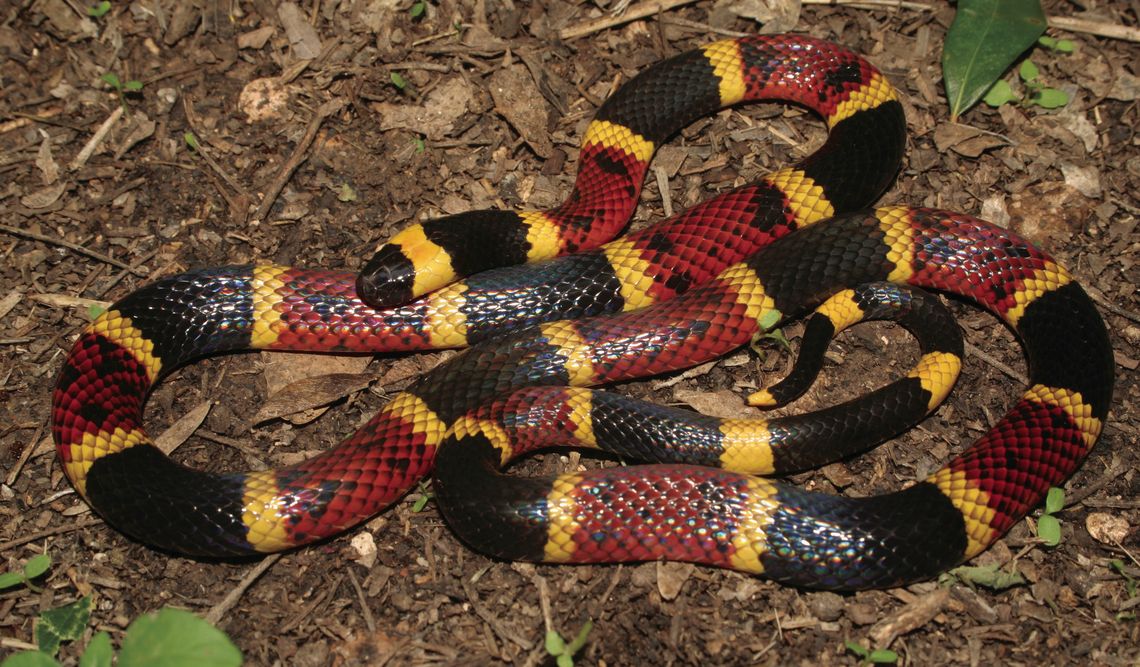I often get requests via email or social media to assist with the identification of a particular animal (I love to do this by the way – so feel free!) On multiple occasions, the request is of a colorful snake that someone has found and the person is fearful that it is a dangerous animal. But out of literally dozens of these requests, I can only recall once where the animal was truly a variety of cobra that resides here in Texas, and that colorful serpent is the Texas Coralsnake.
The Texas Coralsnake (Micrurus tener) occurs from Louisiana and Arkansas westward to central Texas and southward to the Mexican state of Morelos.
In Texas, it may be encountered throughout the entirety of eastern and southern ecoregions, and it is also a common sight in the Hill Country, particularly along the I-10 corridor from San Antonio to Sonora.
However, despite years of stories being passed along generationally, it does not occur in ANY areas in the Panhandle, and its range BARELY extends into the easternmost areas of the Trans-Pecos (several specimens have been recorded from just east of Sanderson). In this range, it resides in areas of thick plant litter that allows it access to the humid subterranean lifestyle that it prefers.
Texas Coralsnakes can be quite visually stunning with their bands of red, yellow and black. The tricolored arrangement of those bands is what sets this snake apart from other similarly colored animals, as the Coralsnake is the only snake where the yellow and red bands touch. While the saying of “Red touch yellow, kill a fellow”, can be problematic to utilize while the snake is in movement, it is still the best way for positive identification. Having said that, however, if you are relying on nursery rhymes on whether you should pick up a snake or not, then you should not be picking up that snake!!
In addition, these vibrant bands encircle the entire body of the snake; the belly is not colored any differently than the back. There is oftentimes a variable amount of black flecking in the red bands, particularly in older, larger specimens.
The head is solid black, followed by a yellow nape ring. There are no red bands on the tail, nor in front of the yellow neck ring.
The vast majority of Texas Coralsnakes that are encountered are generally around 2 feet in length and have a girth roughly the size of a #2 pencil.
However, many specimens exceed those expectations and one true giant that was found along the coast was a whopping 48 inches in length.
The Texas Coralsnake, unlike every other venomous serpent in this state, is not a pit-viper, but rather a member of the cobra family. As such, it is quite different in a multitude of aspects, including its prey selection, its reproduction methods, fang arrangement and its venom composition.
Like its Old-World cousins, the Texas Coral snake practices ophiophagy, meaning that it feeds chiefly upon other snakes. These prey items are subdued not by constriction or by being restrained but rather are overpowered by a virulent venom that is over 8 times more lethal than that of the feared Diamond-backed Rattlesnake. Once the prey item has been grabbed and held on to by the Coralsnake, it will be quickly overcome by the venom.
Unlike the pit vipers, Coralsnakes employ an egg-laying method to reproduce. Animals that utilize this method of reproduction are referred to be oviparous. Reproduction occurs from late summer/early fall OR from late spring/ early summer. Regardless of when breeding occurs, the half-dozen eggs are laid in mid-summer, usually July.
After a two-month incubation period, the extremely colorful and diminutive (7 inch) young emerge from the egg fully prepared to fend for themselves.
Where it occurs, this snake is an extremely abundant species, particularly in garden areas where the combination of watered mulch and paving stones can be utilized for subterranean haunts. As mentioned before, the venom of the Texas Coralsnake is exceptionally powerful, but thankfully, it is an extraordinarily benign species that prefers to defend itself by retreating than by fighting.
In fact, the vast majority of envenomations occur when people either 1.) unknowingly step on the snake or 2.) knowingly handle the snake.
There are many Texas species of nonvenomous snakes that “mimic” the Texas Coralsnake, including the two varieties of Milksnake. However, the pattern arrangement in those nonvenomous all hold fast to the old adage “red touch yellow, kill a fellow; red touch black, venom lack”. But a much better rhyme would be: “if you don’t know, let it go”!





















